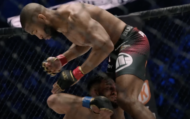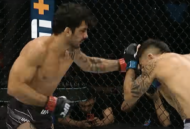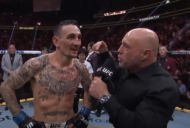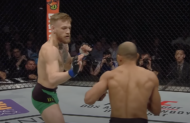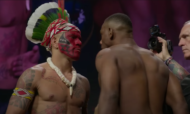Wednesday, Apr 04, 2001
“new” Jersey “rules”
|
"New" Jersey "Rules" By Josh Gross This roller-coaster ride we’ve come to know and love, as mixed martial arts regulation just got very interesting. Months after California’s jarring disappointment, a new light has shone upon the MMA landscape in the form of Larry Hazzard and the New Jersey State Athletic Control Board. After UFC 30 in Atlantic City, Hazzard sent out a notice to all mixed martial arts promoters interested in running shows that there would be a meeting on April 3rd, 2001 in Trenton, NJ to discuss any and all concerns about regulation. The meeting has come and gone, and the fans of MMA should be extremely excited. What exactly did they do? Well, by implementing nine weight classes and keeping the majority of the rules that have thus far been used in MMA competition, the sport of mixed martial arts now has full-fledged regulation in one of the largest combative states in the United States. This is not the half of it. Hazzard, along with Executive Director of the Nevada State Athletic Commission Marc Ratner and several other regulatory bodies are looking into using the rules and regulations compiled on the 3rd as standardized rules for the sport. As a whole, the rules are practically identical to those the UFC and IFC have been running in New Jersey since September, 2000. The rules have been modified, notably the stoppage of knees on the ground, however these new rules don’t reflect any major changes. The most significant are reshuffling of weight divisions and the prohibition of the use of shoes, shirt and gi for a fighter. Although the banning of shoes seems minor, many mixed martial arts fighters based in wrestling have grown accustomed to competing in shoes. In an effort to bring uniformity to the sport, Hazzard felt it was the best course of action. "One concern was of a hygienic nature," said Hazzard as he addressed the no-shoe rule in an interview on "No Holds Barred" with Eddie Goldman. "They felt like that there was less of a chance of debris from shoes being brought into the ring. The other concern was more of a safety issue in that it was felt that the shoes were an advantage over the bare feet in that you have the eyelets in the shoes and things of that nature. It was the consensus of the group that there would be no shoes." Combining the IFC’s weight class system, based on the defunct California rules, and the UFC’s; the nine divisions break down like this. Starting with the lightest category, the Flyweight category features fighters under 125lbs. Next is the Bantamweight division between 125-134.9. The Featherweights are next at 135-144.9. Until now these divisions were dormant in major U.S. promotions and appear likely to remain that way for some time. The new Lightweight division features the likes of Jens Pulver, Kaoru Uno, Din Thomas and many others between the weights of 145-154.9. Pat Miletich will defend his UFC Welterweight, yes welterweight, Championship at UFC 31 against Carlos Newton as the new division with fighters between 155-169.9lbs sees the light of day for the first time. This is where things get interesting. Many in the know felt that the former UFC Middleweight division, with fighters competing between 170-200lbs, needed to be cut in half. The new rules did that, possibly creating some amazing match-ups. The new Middleweight division, includes fighters between 170-184.9lbs, names such as Kazushi Sakuraba, Frank Shamrock, Dan Henderson, Jose "Pele" Landi-Johns, Dave Menne and many others would fall into this category. The possibilities are endless. The top-half of the division isn’t shabby either. Tito Ortiz, Vanderlei Silva, Kevin Randleman and many more won’t have to worry about making 199lbs anymore because the new Light-Heavyweight division includes any fighter 185-204.9lbs. The heavyweights will have a lot of room to play as any fighter from 205-264.9lbs can battle it out. Finally, the really big boys get to tangle in the Super-Heavyweight division above 265lbs. Talk is boxing will gain its own Super-Heavyweight class in the near future. The three-hour meeting went smoothly save discussions on the no-shoe rule and the Super-Heavyweight class. The mixed martial arts promoters on hand, particularly the UFC, are extremely happy with the outcome. "It turned out better than we thought it was going to," said the President of the UFC, Dana White. "We went in there nervous about a lot of things. Maybe they were going to try and take slams out. Who knows what they were going to do. You know what, they were so open minded." Slams didn’t concern Hazzard, or the other commissioners, but "spiking" did. There haven’t been many cases of "spiking", where one fighter drops or throws his opponent directly on top of his head, yet according to White that was the regulators’ main concern. Like in amateur wrestling, "spiking" is now illegal and any flagrant foul will result in an immediate disqualification. During discussions with the California State Athletic Commission, the gloves worn by fighters became a major sticking point. The IFC developed a gel-based 10oz. glove that delivered quite an impact. The New Jersey rules make concessions for gloves ranging between 4-10oz. Each promotion will decide on what gloves and which weight to use. Despite the close similarities in rules between the IFC, UFC, King Of The Cage, Pride and many other promotions, differences remain. It is the hope of many involved that all promotions, particularly in the U.S., will adopt the ‘new’ Jersey rules. "I hope everybody uses these rules," White said from Las Vegas. "That’s what we really have to count on. The reality is, the way this sport has been in the past was like, ‘this is my sandbox and I don’t want anyone else playing in it.’ The way everybody needs to see it now is all the promoters need to work together to make sure this thing doesn’t die." The Athletic Commissions across the U.S. have a parallel struggle. Hazzard was instrumental in the Association of Boxing Commissions’ rules regarding uniform regulations in championship boxing bouts. It remains to be seen if he can pull it off in mixed martial arts, but it’s good to know someone is trying and his efforts haven’t gone unnoticed. Hazzard is not alone in his battle to legitimize MMA. There are many others, including Ratner, who could play increasingly important roles in the year to come. While these rules are a major step forward, we must remember the setback in California. It doesn’t appear like that type of disappointment can happen again, but in the wacky world of mixed martial arts you never know. |
posted by Full Contact Fighter @ 8:00 pm


